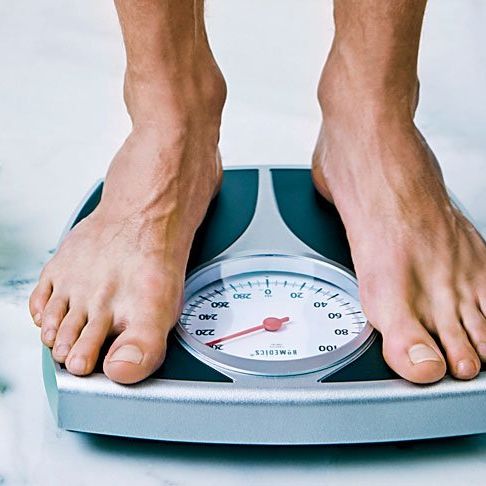Runners tend to have an attraction for numbers, tracking their weekly mileage, various PRs, the wind chill and humidity, and so on. This numeracy can come in handy if you’re planning a weight-loss program for the coming year.
Despite heated controversy on all sides, most weight-loss experts acknowledge that “energy balance” is still the key. To lose weight, you’ve got to burn more calories than you consume. Here are some numbers that will help you track your “in” and “out” totals, and your potential weight loss results.
Calories burned per mile
Runners have long assigned a calorie-burn total of 100 to each mile they cover. This is a reasonable ballpark figure, but only that. You’ll come much closer to your personal per-mile burn if you multiply your weight (in pounds) by .75. In other words, if you weigh 200 pounds, you burn about 150 calories per mile.
Calorie deficit needed to lose a pound
Everyone learned long ago that an energy-balance deficit of 3,500 calories will give you a one-pound weight loss. Thus, this ubiquitous advice: “Aim for a 500 calories per day deficit, and you will reach 3,500 calories in a week, which will reward you with a one-pound loss.”
Unfortunately, the 3,500-calorie figure is wrong by a wide margin, particularly when you start talking about weeks, months, and years of calorie reduction. More accurate: It takes a 7,000-calorie deficit to produce a one-pound weight loss. If you reduce your initial energy balance by 70,000 calories over 12 months, you’ll lose about 10 pounds—not the 20 pounds predicted by the 3,500-calorie rule.
Related: Biggest Weight-Loss Myth Revealed
This sounds discouraging at first. But Kevin Hall, Ph.D., the National Institutes of Health obesity researcher whose math models have produced several innovative papers in recent years, believes there’s another perspective. If you have realistic expectations, he hopes, you won’t get as frustrated when your loss begins to slow down; you'll stick to your goal and keep chipping away. This is the only “secret” of long-term weight loss: You’ve got to hang in there.
How weight loss increases your appetite
The past year’s most explosive weight-loss paper, authored in part by Hall, looked at the results of the “Biggest Losers” six years after the season when they appeared on the popular TV show. On average, they had regained 70 percent of the weight they lost. Sounds bad.
There’s another way to look at this, however. The Biggest Losers had sustained a 12 percent weight-loss after six years, a better outcome than is common among most yo-yo dieters. “This is not failure; it is success!” wrote obesity experts Eric Ravussin and Donna Ryan of the Pennington Biomedical Research Center. “Modest weight loss can produce major health benefits, even in individuals with extreme obesity.”
Related: Good News and Bad News for Biggest Loser Contestants
The Biggest Loser paper introduced the world to “metabolic adaptation,” the multifaceted and dynamic way the body responds to changes in weight. The good news: When you gain weight, you burn more calories every day. Your body actually wants to help you lose the gained pounds.
The bad news: When you lose weight, the body fears that you might be edging toward starvation. It slows your metabolism in a number of different ways, not all well understood. In this scenario, characteristic of modern-day obesity problems, your body wants you to regain the weight you lost.
In several of his papers, Hall has assigned numbers to these regain processes. In November, in the journal Obesity, he showed that every pound you lose increases your appetite by about 45 calories. He had earlier established that every pound you lose decreases your metabolism by about 10 calories. Together, these two processes, neither under your conscious control, contribute 55 calories per day per pound to your body’s regain efforts.
This doesn’t mean that everyone is condemned to regain the weight they lose. The National Weight Control Registry is following more than 10,000 individuals who have lost more than 30 pounds and have kept the weight off for more than five years. Among these weight-loss all-stars, 98 percent changed their diet, many opting for a low-fat approach, and 94 percent increased their physical activity, mostly through more walking. Members of the NWCR also tend to eat breakfast, weigh themselves frequently, and monitor their TV time.
What exercise can—and can’t do—for you
Earlier this month, Obesity Reviews published a paper that looked at how exercise affected weight-loss results. The authors compared exercise + diet trials, with exercise-only trials, and walking and “steps” only studies. They reported that the exercise + calorie reduction studies produced an eight to 11 percent weight-loss in subjects. The other two approaches were much less successful, leading to a two to three percent reduction (exercise only) or a one to 1.5 percent reduction (walking only). In other words, diet is crucial but exercise can add a major boost.
When using exercise to enhance a weight-loss program, it’s important to note two important factors. First, as Canadian obesity researcher Yoni Freedhoff, M.D., has written in his The Diet Fix book: “Exercise is the best medicine ever created.” In other words, you should exercise first for the many mental and physical health benefits, not because it’s a guaranteed weight-loss method. (It’s not, though it can help.)
Second, it takes only a modest weight loss to have major benefits. The American Heart Association has concluded that a three to five percent loss can produce “clinically meaningful” reductions in cholesterol, blood glucose, and blood pressure.
To establish a realistic, science-based weight-loss program, use the tool developed by Kevin Hall and the National Institutes of Health. It’s called the Body Weight Planner.













